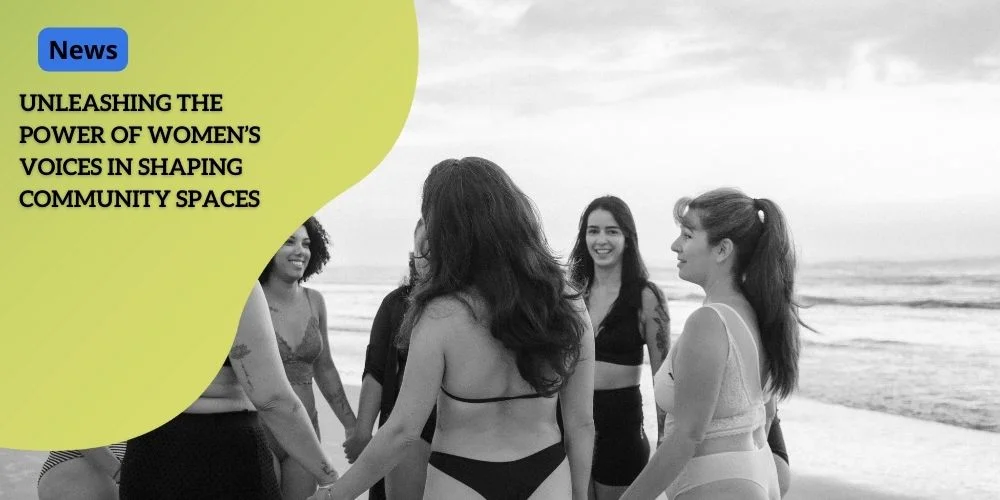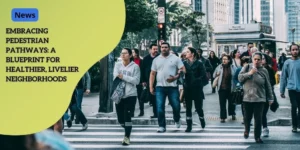Unleashing the Power of Women’s Voices in Shaping Community Spaces

Anúncios
The Unsung Architects: Women’s Influence in Public Spaces
Women as Active Architects: More Than Just Users
It’s easy to overlook the role women play in our public spaces. Yet, their contribution as architects, both literal and metaphorical, is substantial. They do more than occupy space; they shape it to suit their needs and the needs of their community. From city squares to parks and marketplaces, women turn these areas into vibrant, multifunctional hubs. Their influence extends to urban planning decisions and cultural events, which shape community dynamics in subtle yet profound ways.
Creating Safety and Comfort
Women’s impact on public spaces often begins with a focus on safety and comfort. Well-lit pathways, secure transit stops, and clean amenities aren’t just perks—they’re essentials. These elements make public spaces more accessible and inviting. When women participate in the planning process, they advocate for environments where they, along with their families, feel secure and welcomed. This focus helps build a foundation where community life can flourish.
Anúncios
Urban Planning and Cultural Events
While women’s immediate interactions with public spaces are noticeable, their long-term influence is often more profound. They are instrumental in urban planning and organizing cultural events, weaving a rich tapestry of community life. For example, the input from women’s groups can lead to the establishment of community gardens or child-friendly areas, making the space more inclusive. Events such as local markets or festivals, often spearheaded by women, bring neighborhoods together and create shared memories
Building Communities, One Space at a Time
Anúncios
Women’s nurturing spirit is evident in their efforts to foster a sense of community. Whether it’s advocating for practical amenities, organizing social gatherings, or promoting intergenerational connections, women understand the unique needs of their neighbors. This understanding leads to thoughtful inclusions that might otherwise be overlooked, like seating areas near playgrounds or community notice boards where residents can share information.
Sustainable and Inclusive Design
Engaging women in the planning process leads to more responsive, inclusive public spaces. Simple yet impactful design choices—such as drop-off zones, well-lit paths, and community art installations—ensure that these areas cater to a diverse populace. These elements do more than enhance functionality; they also enrich the social fabric of the community, creating spaces where everyone feels they belong.
“`
Fostering Inclusivity: Safety, Comfort, and Shared Interests
Enhancing Safety and Comfort
Ensuring women’s safety in public spaces involves more than just robust design—it’s about creating an environment where they feel secure and comfortable accessing and using these areas. Simple yet effective measures such as well-lit pathways and secure transit stops go a long way in enhancing trust in public infrastructures. When women feel safe while navigating spaces, participation increases, leading to more vibrant and engaged communities. Additionally, clean and well-maintained amenities contribute significantly to their comfort, providing essential services like accessible restrooms and baby-changing facilities.
Ensuring Well-Lit Pathways and Secure Transit Stops
The importance of lighting in public spaces cannot be overstated. Both in urban and suburban areas, well-lit pathways deter crime and provide clear visibility, which is crucial for perceiving and handling potential threats. Secure transit stops with surveillance cameras further bolster this sense of security, allowing women to use public transportation without fear, especially during non-peak hours.
Importance of Clean Amenities
Cleanliness directly affects how public spaces are perceived and used. Amenities like clean restrooms and water fountains significantly enhance comfort and the overall experience. Proper maintenance ensures these facilities cater to women’s needs, fostering a welcoming atmosphere.
Creating Spaces for Shared Interests
Beyond physical safety and comfort, fostering inclusivity requires catering to shared interests and activities that bring women together. These communal spaces foster a sense of belonging and support, essential for building resilient communities. Community gardens, fitness classes, and art workshops specifically designed for women are perfect examples of such inclusive spaces.
Community Gardens
Gardening is not just a hobby; it’s a fantastic way for women to connect over a shared interest, learning and growing together. Community gardens offer a serene escape from daily life while providing a platform for social interaction and support.
Fitness and Wellness Classes
Public spaces hosting fitness and wellness classes can address the unique health needs of women, promoting physical well-being and offering a chance to build supportive networks. Whether it’s yoga, aerobics, or dance classes, these activities foster camaraderie and a sense of community spirit. By incorporating these elements, public spaces become more than just functional—they transform into inclusive realms where women feel safe, connected, and valued. This not only enhances their quality of life but also enriches the broader community fabric. Source: Understanding Women’s Influence in Public Spaces “`
Community Champions: Women’s Nurturing Spirit
Promoting Intergenerational Connections
Women often possess a unique ability to envision public spaces that cater to diverse age groups. This nurturing instinct translates into advocating for practical amenities and establishments that foster intergenerational connections. Picture a local bakery that doubles as a meeting spot for seniors in the morning or a park with play areas adjacent to comfortable seating for parents and grandparents. These thoughtful additions ensure that all community members, regardless of age, feel welcome and engaged within the same space.
Detail-Oriented Advocates
Women’s keen eye for detail cannot be underestimated. They often identify and push for the installation of essential features such as clean restrooms, shade structures, and hydration stations. Their understanding of community needs contributes to the overall functionality of public spaces, making them more user-friendly and socially cohesive. For instance, a local mom might advocate for more frequent trash pickups in playgrounds, ensuring these areas remain clean and safe for children.
Enhancing Social Cohesion
Practical amenities, championed by women, pave the way for enhanced social interactions. These features create environments where people naturally gather and connect, reinforcing community bonds. From family-friendly picnic areas to community gardens that allow for shared experiences, these spaces become beacons of social cohesion, all thanks to women’s persistent advocacy.
- Community gardens where older generations share gardening tips with younger ones.
- Spaces that accommodate activities from young children to senior citizens.
Conclusion: The Backbone of Vibrant Public Spaces
The nurturing spirit of women plays a pivotal role in shaping public spaces. Their relentless advocacy for practical amenities and their attention to detail enrich communities and fortify social cohesion. Recognizing their contributions helps us create more inclusive, vibrant spaces that cater to everyone’s needs. As we move forward, incorporating women’s insights into urban planning and public space design is vital for fostering interconnected and dynamic community environments. Women, as Community Champions, truly are the backbone of our shared spaces. “`
Modern Muses: Aesthetics, Caretakers, and Vendors
Shaping Urban Aesthetics
Women have a unique influence on the aesthetics of public spaces. Their preferences often guide urban design choices, which has led to an increase in chicly designed, visually appealing spots – commonly referred to as “Instagrammable” locations. These spaces, characterized by their striking visuals and inviting ambiance, not only enhance the urban landscape but also serve to attract a diverse range of visitors, promoting economic activity and community interaction. This trend is more than just a fad; it reflects a drive towards creating spaces that are both functional and beautiful, tapping into the creative pulse of the community.
Caregivers of Public Spaces
Women play critical roles as the everyday caretakers of public spaces. From event organizers to street vendors, their contributions are vital in maintaining the functionality and vitality of these areas. They ensure that public spaces are kept clean, vibrant, and welcoming. Their engagement ranges from managing community events that draw in local crowds to providing essential services that enhance the overall user experience. This layer of involvement is integral to sustaining an environment where everyone feels comfortable and connected.
Women as Event Organizers
Whether it’s organizing local markets, cultural festivals, or neighborhood gatherings, women often take on the role of event coordinators. Their efforts help to cultivate a sense of community and belonging among participants. These events provide platforms for social interaction and cultural exchange, further cementing the role of public spaces as community hubs.
Women in Commerce
Street vendors and local shop owners, many of whom are women, bring a dynamic aspect to public spaces. They offer a variety of goods and services, from food stalls to artisanal crafts, contributing to the local economy and making public areas lively and interesting. Their presence not only supports livelihood but enriches the community’s daily life.
Maintaining Social Cohesion
Women’s attention to detail and understanding of community needs enhance social cohesion within public spaces. They advocate for practical amenities that cater to all generations, such as restrooms, shaded areas, and hydration stations. By doing so, they ensure that public spaces are inclusive and accessible, promoting social interaction and connectivity. This nurturing approach helps build resilient communities where people of all ages and backgroundsfeel welcomed and integrated.
Practical Amenities for All
Practical amenities are crucial for making public spaces user-friendly. Women’s advocacy often results in the inclusion of features like clean restrooms, baby-changing facilities, and shaded seating areas. These elements are essential for making spaces accessible and comfortable for everyone, from young families to the elderly. Such amenities enable extended usage of public areas, facilitating more meaningful social interactions and fostering a stronger sense of community.
Creating Vibrant, Inclusive Spaces
Inclusive design is imperative for building vibrant public spaces. Engaging women in the planning process ensures that a varied set of perspectives are considered, resulting in spaces that cater to diverse needs and interests. This might include well-lit walking paths for evening strolls, designated drop-off zones for parents, or community art installations that feature local female artists. By focusing on inclusivity, public spaces can become nurturing environments that cultivate community ties and enrich urban life.
Community Art and Cultural Expressions
Women’s involvement in public space design often brings a unique cultural sensitivity and appreciation for community art. Public art installations and cultural expressions curated by women can transform ordinary spaces into extraordinary ones, resonating with local history and identity. This approach not only beautifies the area but also instills a sense of pride and belonging among community members.
Safe Pathways and Drop-Off Zones
Safety is a critical consideration when designing public spaces with women in mind. Features such as well-lit pathways and secure drop-off zones are essential for enhancing safety and accessibility. These elements allow women and families to enjoy public spaces without concern, making these environments more inviting and usable during various times of the day.
Cultivating an Inclusive Future
Acknowledging the myriad ways women contribute to the vitality of public spaces is essential for creating richer, more inclusive environments. Their influence extends far beyond immediate uses, impacting everything from urban aesthetics to community dynamics. By listening to women’s voices and actively involving them in the planning and development of public spaces, we pave the way for more inclusive and dynamic communities.
A Call to Action
It’s time to give credit where it’s due. Recognizing and integrating women’s insights into public space design isn’t just about fairness; it’s about enhancing the quality of life for all. By valuing the contributions of women as modern muses, caretakers, and vendors, we can create public spaces that are beautiful, functional, and inclusive. Together, we can build vibrant hubs that reflect the diverse tapestry of our communities. Ultimately, the goal is to recognize and foster the invaluable influence women have on public spaces. By designing with their needs and preferences in mind, we can create areas that not only look stunning but also support the well-being and cohesion of the entire community. These modern muses remind us that beauty, functionality, and inclusivity can and should coexist in our communal environments. “`
Designing with Women in Mind: A Call to Action
Engaging Women in the Planning Process
Actively involving women in the planning and development of public spaces ensures these areas cater to a wide range of needs and interests. Women bring unique perspectives and practical insights gained from their everyday use of these environments. Urban planning committees and design teams that include women can better identify issues related to safety, accessibility, and utility that might otherwise be overlooked.
Inclusivity Through Practical Design
By understanding women’s daily routines and challenges, planners can incorporate specific elements that address these needs. For example, well-lit walking paths, especially crucial for women who may feel unsafe after dark, can significantly enhance their sense of security
Similarly, drop-off zones close to busy areas help mothers with young children manage their time more effectively.
Creating Vibrant and Inclusive Environments
Public spaces designed with women’s interests in mind can become vibrant community hubs. Incorporating amenities like clean, accessible restrooms and seating areas caters to women’s comfort, promoting longer and more frequent use of these spaces.
Community Art Installations
Art installations that reflect local culture and community values can create a sense of identity and belonging. Involving female artists and encouraging community-based art projects can enhance the aesthetic appeal and emotional connection people have with public spaces






